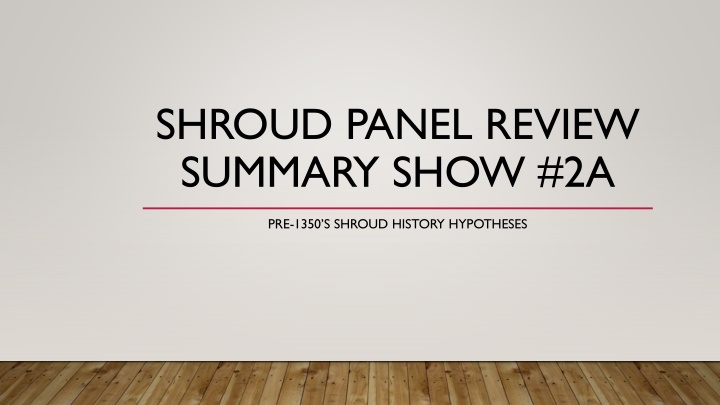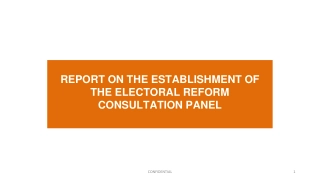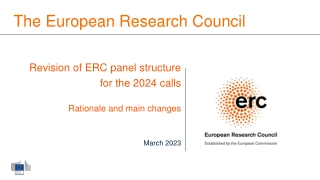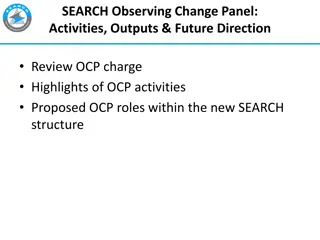
Historical Hypotheses of the Medieval Missing Years for the Shroud Panel
Explore the historical hypotheses surrounding the whereabouts of the Shroud Panel during the Medieval Missing Years (1204-1356 A.D.), including text-based theories and forgery-based theories proposed by experts. Delve into the mystery and controversy of the Shroud's provenance during this period of uncertainty.
Download Presentation

Please find below an Image/Link to download the presentation.
The content on the website is provided AS IS for your information and personal use only. It may not be sold, licensed, or shared on other websites without obtaining consent from the author. If you encounter any issues during the download, it is possible that the publisher has removed the file from their server.
You are allowed to download the files provided on this website for personal or commercial use, subject to the condition that they are used lawfully. All files are the property of their respective owners.
The content on the website is provided AS IS for your information and personal use only. It may not be sold, licensed, or shared on other websites without obtaining consent from the author.
E N D
Presentation Transcript
SHROUD PANEL REVIEW SUMMARY SHOW #2A PRE-1350 S SHROUD HISTORY HYPOTHESES
THE MEDIEVAL MISSING YEARS (1204-1356 A.D.) Starting in the mid 1350 s A.D., with Geoffrey 1 de Charney in Lirey, France, the Shroud s historical provenance is relatively uncontroversial for all (Pro-Shroud and Shroud skeptic alike) Virtually all Pro-Shroud authenticists and experts believe that the Shroud was in Constantinople and attested to as Jesus burial shroud as of 1203/1204 A.D. just prior to the sacking of the city during the 4thCrusade. Read Crusader soldier, Robert de Clari s quote #1 in his Chronicles (August 1203 A.D.)- Ian Wilson 2010 book, p.152. However, the whereabouts of the Shroud during the period from 1204-1356 A.D. Is the subject of much debate amoungst Shroud historians today- no one knows for sure!
SOME KEY RELEVANT FACTS The Shroud was not referenced much after 1204. No explanation given for how Geoffrey 1stde Charny got the Shroud. Apart from the fact that it was freely given and not sold to him. Geoffrey in 1343 A.D. (same year he becomes a knight) asks King Philip for financial help to build a church in small town of Lirey (suggesting he already had the Shroud prior to 1343 A.D. and wanted to build the church to show it).
THE MEDIEVAL MISSING YEARS HISTORICAL HYPOTHESES (1204-1356 A.D.) To date, there have been about 16 historical hypotheses proposed by Pro-Shroud experts to explain the whereabouts of the Shroud from the sack of Constantinople in 1204 A.D. to the exhibition of the Shroud in Lirey, France during the 1350 s A.D. Shroud historian Jack Markwardt has done a lot of research into these theories and categorizes the various hypotheses into 3 main types of theory; i) Text-Based Theories- Theories that attempt to account for all relevant historical texts during the period. ii) Ad Hoc/Fiction-Based Theories- Theories that are founded upon one or more unproven or fictional assumptions. iii) Forgery-Based Theories- Theories based on a forged letter known as the Theodore Letter (a proven forgery by secular historians based on 8-11 irrefutable or strong reasons- no original/copies for 700 years, obvious errors, wrong style, etc.).
TEXT-BASED THEORIES: 4 RELEVANT HISTORICAL TEXTS (C. 1203-1356 A.D.) 1. Robert de Clari (August 1203-1204 A.D.)- Read 2ndQuote for Disappearance Fiction narrative in Ian Wilson, p.152. Unfortunately, Robert was not well-informed as a poor knight serving in the ranks and simply reports what he was told. He was not in a position to know what the Crusade leaders knew. Weak evidence at best for Disappearance aspect. 2. Geoffrey de Villehardouin Chronicle (1204 A.D.)- written by a noble Crusader leader who doesn t explicitly mention the Shroud, but he tells us that just before the sacking of the city, the troops went to sleep and the leaders went into the city themselves first and garrisoned the two palaces with the relics in them (including the one Robert mentioned- Blachanae Palace-) so that the ordinary men would not touch any of the Passion Relics the following day = https://sourcebooks.fordham.edu/basis/villehardouin.asp 3. Nicholas of Otranto Disputation Report (1207 A.D.)- he lists off the palace relics after the sacking including the burial cloth relic when he came to the city in 1204/5 A.D. Also, Nicholas Mesarites Eulogy where Nicholas Mesarites, the former Byzantine custodian of the imperial relic collection who had affirmed, in 1201, that the Pharos Chapel housed the linen burial cloths of Jesus, was replaced by a Latin cleric and left Constantinople after it had fallen to the crusaders in April of 1204; however, when his brother, John, died in 1207, he returned to the capital and, in delivering his brother s eulogy, recited that the othonia and the sudariums of Jesus still remained in the city as of 1207 A.D. 4. Baldwin 2nd Golden Bull (1247 A.D.)- the Latin Emperor Baldwin II issued a Golden Bull in which he ceded, in perpetuity, all of his rights in twenty-two enumerated relics which his cousin, King Louis IX of France, had previously acquired and transported to Paris, one of which was "part of the shroud with which his (Jesus') body was wrapped in the tomb". May only refer to only a cut off piece of Shroud???
SIX TEXT-BASED THEORIES Text-Based Theory 1. The Touchy Theory #1 (Original by Pietro Savio in 1957). 2. The Touchy Theory #2 (Modified theory by historian Dorothy Crispino in 1997 A.D.) 3. The Pawned Relic Theory (by Priest Paul De Gail in 1973 A.D.) 4. Saint Chappelle Theory #1 (by Andre-Marie Dubarle & Hilda Leynen (1998 A.D.) 5. Saint Chappelle Theory #2 (Mario Latendresse in ~ 2012). 6. The Simony Theory (by Jack Markwardt in 2017 A.D.)
AD HOC/FICTION-BASED THEORIES: 3 HISTORICAL FICTIONS 1. The Disappearance Fiction- The Shroud disappeared in the chaos of the Crusade sacking of the city in 1204 A.D. 2. The Smyrna Fiction- Geoffrey 1stde Charney went on Crusade to Smyrna to get the Shroud (he knew it was over there). 3. The Othon de la Roche/Besancon Fiction- In 1523 A.D., a Shroud shows up in Besancon France and the clergy need to explain how it is an authentic relic and so they make up a story to make it a Byzantine relic via Othon De Laroche, a supposed crusader who got it in 1204 A.D. sack and then took it to Athens and then later to his home town cathedral in Besancon, France. [The clergy of 1711 A.D.??? Said that it arrived in 1350 s not 1523 A.D.].
SIXAD HOC/FICTION-BASED THEORIES Ad Hoc/Fiction-Based Theory 7. The Knights Templar Theory (by historian Ian Wilson in 1978-2010 A.D.) From Unknown thief in 1204, then sold or given to the Templars & after they lose Holy Land in 1291 A.D. bring it back to France to be inherited by Geoffrey 1stde Charney by 1350 s A.D. [Disappearance-Based Fiction]. 8. The Cathar Theory (by Jack Markwardt from 1997-2000 A.D.) This was Jack's original theory from 1997-2000 A.D. (he no longer holds this view- see Text-Based Theories above). Jack himself says while this is a plausible theory, he thinks the Knights Templar theory is superior all things considered given this theory says Geoffrey got the Shroud after 1343 A.D. and so doesn t explain his plan to build a church in small town Lirey when knighted. [Disappearance-Based Fiction]. [Disappearance-Based Fiction]. 9. The VostitzaTheory #1 (by Joseph Du Teil in 1902 A.D.) 10. The VostitzaTheory #2- Geoffrey crusaded in Smyrna. [Smyrna-Based Fiction]. 11. The Besancon Theory #1 (Dom Chamard in 1902 A.D.) [Othon De La Roche/Besancon-based Fiction].
FOUR FORGERY-BASED THEORIES (BASED ON THE FAKE THEODORE LETTER ) Forgery-Based Theory 13. The Athens-Templar Theory (by Noel Currer Briggs in 1988 A.D.) 14. The Athens-Smyrna Theory (by Daniel Raffard Di Brienne in 1997 A.D.) 15. The Ray-VergyTheory (by Alessandro Piana in 2007 A.D.) 16. The Ray-Vergy-Besancon Theory (by historian Daniel Scavone in 2008 A.D.).
INFERENCE TO THE BEST EXPLANATION For the sake of time and convenience, I have adopted Shroud historian Jack Markwardt s categorizations and assessments of the various theories in terms of their initial historical plausibility (though having listened to his reasoning, and briefly researched some of the issues over the past 2-3 days, I largely agree with his take). We will assess the evidence for and against each theory in the light of the BEI or Best Explanation Inference criteria. Plausibility- prior probability of being true given our background knowledge. Explanatory Scope- how many facts and data points does it explain. Explanatory Power- how well does it fit the evidence and data. Less Ad Hoc- how many non-evidenced assumptions does it need to employ. The best explanation is more likely to be the truth!
ASSESSING THE TOP 3 HISTORICAL HYPOTHESES -THEORY #7-THE KNIGHTS TEMPLAR THEORY - The Knights Templar Theory- first proposed by historian Ian Wilson in 1978 A.D. Wilson argued that in 1204 an unknown person stole the Shroud in the chaos during the sacking of Constantinople. Then, at some point, the Shroud was somehow transferred to the Knights Templars who held it in the Holy Land until the last Crusader outpost Acre fell to the Muslims in 1290/1291 A.D. when they then took it to France to protect it. In 1307-1314 A.D. Geoffrey De Charney was the last Templar to own the Shroud but he was arrested and then burnt at the stake and so it was then transferred via inheritance through his family until it arrived at his descendant Geoffrey 1stde Charny who exhibited it in the 1350 s A.D. *** Note- that despite the similar names, there is no provable link to the two Geoffreys as being related or of the same family (the name was very common at that time).
TEMPLAR THEORY-SPECIFIC FACTS The Templar theory s truth is supposedly established by 4 lines of direct evidence: 1. The Templar Head Idol - Part of the secret initiation ritual was to see the Supreme Vision of God on Earth that was held to be a head idol that was terrifying and awesome and represented God s presence on Earth in a way far more so than the normal Mass. Some debate about whether the Templars really worshipped a head or not (maybe just the French King s propaganda lies to go after them) & even if they did worship a head idol, there is no evidence of what it was (no mention of a cloth and images)- so some have speculated it was a demon or Muslim-based image but not necessarily Jesus (Wilson, p.264). I think it is probable that they venerated/worshipped a head and it was the image of Jesus face given all the evidence, but no evidence it was probably the Shroud of Turin in particular or another Jesus face image-bearing thing. Also, if it was the Shroud folded into four, then why only mention the face and not mention of body images or blood and also some say he has face of a demon?)- This is an ad hoc component (no mention of full figure of Shroud Man when unfolded or of a burial shroud/cloth at all). 2. The Templecombe Panel- In 1951 A.D., a portrait panel discovered of a celestial head of Jesus that in some ways resembles similar facial portraits of Jesus and the Mandylion in the Byzantine Empire. Again no proof that links it to the Shroud vs. based on another cloth with Jesus head/face image on it.
TEMPLAR THEORY-SPECIFIC FACTS 3. Barbara Frale sVatican Letter- She was a Vatican Archive specialist and in 2008 claimed to have discovered a document mentioning the secret initiation ritual that said in 1287 A.D. Arnaut Sabbatier was shown a long linen cloth on which was imprinted the figure of a man (Wilson P.270). Unfortunately her credibility has been damaged as her translation of the word for linen has been proven to be false and is instead wood (see Ian Wilson and Andrea Nicoletti s critiques of her work on this). 4. Name Similarity- Gofferey De Charnay burnt at the stake for heresy as a Knight s Templar- supposedly he had the Shroud and related to Geoffrey 1stDe Charny who showed the Shroud in the 1350 s. Unfortunately, there has been no proof at all to demonstrate any relations between the two Geoffrey's to date (over 40 years now), the name is very common as Charny refers to a place and there is different spellings of the names (though at that time spelling was not standardized and doesn t prove or disprove anything).
ASSESSING THEORY #7- THE KNIGHT S TEMPLAR THEORY Plausibility- Generally speaking, this theory is historically plausible and consistent with our background knowledge. The Templars had the means, motive and opportunity to obtain, hide and pass on the Shroud. Also plausibility may depend on background knowledge of whether the Shroud was the Mandylion/Image of Edessa vs. Image of God Incarnate or perhaps another burial Shroud held in Constantinople. Explanatory Scope-This theory does account for Robert De Clari s Chronicle very well, however, it is based on the Disappearance-narrative and as such it seems to be inconsistent with other texts that mention the burial shroud/s being present in Constantinople in possession of the Latin Emperors post 1204 A.D. (from 1205-1207 A.D. and possibly beyond). Explanatory Power-This theory does have good explanatory power (outside of explaining some of key texts) in that it explains why the Shroud went missing, the silence in terms of how Geoffrey got the Shroud, explains Geoffrey's 1343 plan to build Lirey church and fits the freely given data. LessAd Hoc- Assume with no evidence that Geoffrey De Charney burnt as Knights Templar is related to Geoffrey 1stde Charney who first showed Shroud.
ASSESSING THEORY #7- THE KNIGHT S TEMPLAR THEORY Peer-Review/Scholarly Consensus: Ian Wilson has not defended his views in the peer- reviewed as it has been critiqued by several historians and scholars since 1978; dee for example, Dan Scavone (supports Wilson on Mandylion/Image of Edessa theory though), Malcom Barber (Templar scholar says no such thing as a Templar idol) and Gian Maria Zaccone (says no proof for the theory). My Final Conclusion is that we don t have sufficient positive reason to believe this hypothesis is probably true historically. However, I do think it is a plausible and equally probable historical explanation for where the Shroud may have been between 1204-1356 A.D. I assign a conditional probability P (E|KT) of 80% and 90% Prior Prob/Plausibility factor (not 100% given the Mandylion foundation issue- generous to skeptics).
ASSESSING THE TOP 3 HISTORICAL HYPOTHESES -THEORY #5- SAINT CHAPPELLE THEORY #2 - In about 2012 A.D., Mario Latendresse proposed his hypothesis that the Mandylion, ceded to King Louis IX by Baldwin II was actually the Shroud. His hypothesis is that it was kept in its original Byzantine reliquary for about a century in the Grande Ch sse of the Sainte-Chapelle, then given to Geoffroy de Charny by King Phillippe VI de Valois as a gift for his great services to France (a reward freely given ). Latendresse has carefully studied the inventory records of relics contained in the Grande Ch sse of the Sainte-Chapelle, and claims that the last inventory taken before the French Revolution indicates that the Mandylion cloth was no longer in its reliquary.
THEORY #5- SAINT CHAPPELLE THEORY #2 - SPECIFIC RELEVANT FACTS - Positive & Negative Direct Evidences: Golden Bull of 1247 A.D.- Mentions the giving away of a golden towel . But this is really a negative evidence as it s not called a holy Shroud/cloth but a holy towel . Additionally, there is no mention of an image at all in this Bull. Lirey Clerics writing form 1525 A.D. saying that Geoffrey 1st was given the Shroud from King Philip of France (but writing is ify amoung historians as much later [200-300 years after the fact & fanciful in that says he was released from prison by angels]. Too late and questionable historical value to matter. There are similarities between some of the other relics in Saint Chappelle reliquary and ones in the Lirey church (1418 Receipt during temporary move from Lirey to safe location during the war). No inventory references to a cloth, but do mention a face and earlier a trellis not toile (cloth)- a mistake Mario says (blouse example).
ASSESSING THE TOP 3 HISTORICAL HYPOTHESES -THEORY #5- SAINT CHAPPELLE THEORY #2 - Plausibility- This theory is historically plausible given the background knowledge. Mario himself equates the Shroud with the Mandylion/Image of Edessa, however Jack Markwardt mentions that it is equally consistent with the Image of God Incarnate notion or the Shroud being another imaged cloth as well- thus, settling that question doesn t necessarily impact on plausibility. Explanatory Scope- This theory does account for all of relevant texts mentioning the Shroud in Constantinople post-1204 A.D. There potentially some strain in explaining the part of Robert De Clari s Chronicle attesting to the Disappearance-narrative and as such it seems to be inconsistent with other text, however, this part of the text is unsubstantiated or unproven and so theories don t need to assume a disappearance in 1204 A.D. is historical. Explanatory Power- This theory does explain why the inventory list taken before the French Revolution says that the Mandylion cloth was no longer there (as it was freely given to Geoffrey 1st in the 1350 s by the King of France); however this in and of itself, does not positively prove that the theory is true. It also explains why the Shroud was unmentioned during the missing years and the freely given aspect, but it fails to adequately explain why there would be silence on how Geoffrey got the Shroud and is ambiguous if it explains Geoffrey 1st s 1343 A.D. plan to build church as most likely got Shroud in 1347 A.D. as a councilor LessAd Hoc- Assumes that the Shroud was the Holy towel, assumes towel and/or trellis vs. toile/cloth is an error in the same blouse was error, and assumes the French didn t know about Mandylion and the French overlooked the image entirely (but Robert de Clari mentions the imaged Shroud in 1203, so they did know of it, why didn t the French ask about it). Peer-Review: Critiqued by Ian Wilson, Dan Scavone, Mark Guscin, Cesar Barta and skeptic Andrea Nicoletti who all deny that the holy towel was the Shroud. Mario has defended his views despite the controversy amoung experts. I assign a conditional probability P (E|SC2) of 60%-65%-70% and 100% Prior Prob/Plausibility factor.
ASSESSING THEORY #6- THE SIMONY THEORY Proposed by Jack Markwardt in 2017 A.D. Says that the Shroud stayed in Constantinople after 1204 A.D. as relics of Latin Emperors until Baldwin 2ndwhen he went bankrupt and needed money desperately; so he wanted to sell relics (21-22 of them total) to King Louis 9thof France (a saintly king) from 1239-1241 A.D. But buying and selling holy relics was the mortal sin of simony which entailed the King could lose his thrown and so they did a relic as collateral scheme (confirmed by the 1247 A.D. Golden Bull). However, for the Shroud he pays a King s ransom to free an important hostage (mistakenly thinking this avoided the sin of simony), but unfortunately he paid money and obtained the Shroud relic directly, but advisors told him this is sin and so he had to get rid of it. He secretly gave it to his good friend Jean de Joinville (owner of Lirey as of 1290 A.D.) to hold for him. King left him behind (unusual as he always went with the King before) but King dies on crusade and so Jean keeps it until he dies. Not able to reveal it as King would lose his sainthood. Between 1290-1295, his daughter marries the knight Jean de Charny. Joinville is 85 years old and so Shroud given as Dower property (for the woman to retain on her own apart from husband to dispose of anyway she wishes). Margaret de Charny swore oath to her father not to reveal how Shroud obtained. In 1306 A.D., she dies young and so she left her dower property to non-eldest son Geoffrey 1stas inheritance.
ASSESSING THE SIMONY THEORY Plausibility- This theory is historically plausible given the background knowledge. The acquisition and transfers of the Shroud are all plausible. This is also consistent with the evidence of Luis lust for relics and will to work around Simony sin, his ransom of Philip (and his working for Louis afterward) and fits with our new knowledge (as of 1996 A.D.) that Geoffrey 1stwas Joinville s grandson via marriage. Explanatory Scope- This theory does account for all of relevant texts mentioning the Shroud in Constantinople post-1204 A.D. There potentially some strain in explaining the part of Robert De Clari s Chronicle attesting to the Disappearance-narrative and as such it seems to be inconsistent with other text, however, this part of the text is unsubstantiated or unproven and so theories don t need to assume a disappearance in 1204 A.D. is historical. Explanatory Power- This theory does explain why the Shroud was unmentioned during the missing years and the freely given aspect, also adequately explains why there would be silence on how Geoffrey 1stgot the Shroud as well as Geoffrey 1st s 1343 A.D. plan to build church as he got it via his first marriage prior to that date. LessAd Hoc- No non-evidenced assumptions employed for the theory to work. Peer-Review: None yet as it is too new a theory. Let s Assign a 95% Probability of seeing the evidence given this theory is assumed true (due to no Peer-review yet) and 100% Prior Probability/Plausible.
ASSESSING SHROUD SKEPTICAL HYPOTHESES 1. The Medieval Mad-Artist Theory- Many Shroud skeptics have a ridiculous notion that some random medieval artist worked out how to make the Shroud images on his own and then sold it off to Geoffrey 1st (or other who ultimately then transferred to Geoffrey 1st)- leaving the process unknown to anyone else. This is historically implausible as artists in the medieval period were not lone wolves for hire, but instead were seen as craftsmen with many people being involved on a given project. Also if artist deliberately make Shroud images (or hired to do so), why use big church altar cloth and not one more like burial shroud- it must be the cloth was not their choice for one reason or another (but mad artist not have many rich altar type cloths to use in trial and error for making the images). Don t believe me Shroud skeptics? Even Hugh Farey says as much in my Panel Review Part 1 show (see the 8:08 min mark to the 10 min mark). Let s say a 5-10% Prior Probability of the evidence given the theory is presumed true to be Generous to the Shroud Skeptic = Failed! 2. Hugh Farey s Quem QuaeritisTheory- See Hugh explain his own theory in my Shroud Panel Review Part 2B show (from the 25 min mark Jack asks Hugh question to 33 min mark). Hugh says the Shroud images were probably made around the 1290 s A.D. [Originally he proposed the 1340 s A.D.]. Let s assign a generous 80% (or 1-.8 = 20% Positive terms) Probability of the evidence given this theory is assumed true and 95%-100% Prior Probability/Plausible.
ASSESSING QUEM QUAERITIS THEORY Plausibility- This theory is historically plausible given the background knowledge in so far as the Quem Quaeritis ceremony was widely known to have been practiced throughout France at this time. However, it may lack plausibility in two ways; i) the scientific evidence for how the images were made rules out this method of forming Shroud images (no assume that this is the case for our strictly historical purposes), and ii) it is unlikely that the cloth would have been freely given to a small town church like Lirey vs. another one (Hugh says the cloth rejected by bigger church originally due to some defect, but no proof of this and again more likely it would be given to a church that was bigger than Lirey yet smaller than the original big church and/or discarding it altogether). Now, if the ritual was as common as Hugh notes and all of them regularly involved images on the shrouds used, then why would anyone fall for the Shroud of Turin as legit- the masses would all know it s a fake and not pay money for it in Lirey. But more likely, images were not commonly on these ritual shrouds and so only the Shroud of Turin taken as real- so deliberate mislead or dexived themselves maybe as images washed off so looks different maybe as Hugh s counter. Explanatory Scope- This theory does NOT account for all of the relevant texts mentioning the Shroud in Constantinople post-1204 A.D. However, I m unsure if this is able to rule out this theory given there were multiple burial linens/cloths (even with images) at this time, and so it may be these texts refer to other cloths and not the Shroud. Explanatory Power- This theory doesn t explain or prove the when, how and why it was freely given to Geoffrey 1st. It also explains why the Shroud was unmentioned during the missing years (namely it didn t exist to be mentioned in the first place) and does explain the freely given aspect,but it fails to adequately explain why there would be silence on how Geoffrey got the Shroud. It does potentially explain Geoffrey 1st s 1343 A.D. plan to build church as it is possible to suppose he got it before that date. Finally and most importantly, this theory does not fit the fact that none of the Quem Quaeritis ceremonies written about mention anything about images on their cloths. LessAd Hoc- Hugh admits that this theory is pure speculation with no direct evidence to support it (aside perhaps from the D'Arcy Memo- already refuted in Shroud Panel Review Parts 2 and 2B). None of the other shrouds from these rituals survive to the present day, Hugh must assume that they involved images on the cloth without any proof. Peer-Review: None.
FINAL CONCLUSION Simplified Bayesian Approach (For Best Known Pro-Shroud vs. Best Known Skeptical Hypothesis Only); (.95)(1.00) /(.95)(1.00) + (.8)(1.00) = = (.95) / 1.75 = 54.3% = 54% that the Simony Theory is true over and against the best Shroud Skeptical theory by Hugh Farey. That said, in order for an inference to the best explanation to be warranted, we would also need to factor in the probability that the fulfillment of such criteria is indeed truth revealing (85% I assign) and also we need to be more exhaustive in considering other potential Shroud skeptical hypotheses beyond the two we did here as there may be other possibilities that don t have the problems that those two theories had. Overall Conclusion: Incomplete assessment at this time, but gives one the foundation and methodology for how one might go about constructing an abductive argument on this front to favour the Pro-Shroud side over the skeptical side.






















